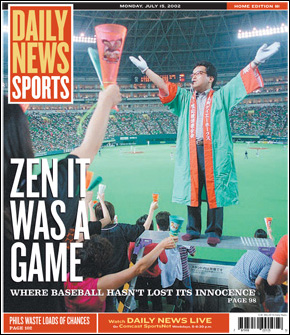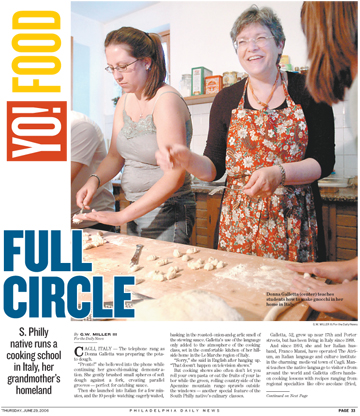Zen it was a game
Baseball in Japan: where the game hasn't lost its innocence.
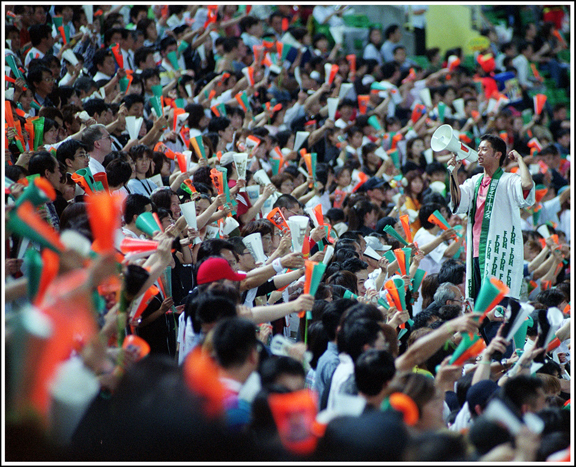
Published on July 15, 2002 in the Philadelphia Daily News.
NAGOYA, JAPAN -- Scott Sheldon launched a home run deep into the left field stands and before the ball even landed, the bands were playing, giant team flags were being waved and the crowd was raucously banging their megaphones in the air and screaming in unison.
Sheldon rounded the bases and was greeted at the plate by a young girl in a shiny pink outfit who handed him two stuffed animals of the team mascot. He jogged towards the dugout, high-fived his teammates - who were all standing out on the field - and then threw the stuffed animals into the cheering masses in the stands.
Bands, flags and stuffed animals? This wasn't heaven and it certainly wasn't Iowa. Or Philadelphia.
This field of dreams was in Nagoya, Japan and Sheldon's team was the Orix Blue Wave, former team of Major League superstar Ichiro Suzuki. The solo homer in the sixth inning put the Blue Wave on top of the Fukuoka Daiei Hawks 4-2 in a game the Wave would eventually win 7-3.
The amazing thing was that the fans were cheering the whole time, before and after the dinger. In fact, from the moment the game started, the Nagoya Dome was filled with the banging of drums, the squealing of horns and the screams of organized supporters.
Unlike Veteran's Stadium, where you hear the beer vendors more than the fans, the atmosphere in Nagoya was that of a Big 10 football game. And while Sheldon, a former utility player with the Texas Rangers, would probably prefer to be a hero in a land where he actually understood the language, the fan appreciation he was receiving on that day would never be equaled back home in the United States.
***
Commodore Matthew Perry parked his battleships in Tokyo Bay in 1853 and demanded that Japan negotiate a diplomatic and trade agreement with the United States. Japan had undergone over two centuries of self-imposed isolation from the outside world - communication with foreigners was banned by the shogun in all but one area of the small island nation. Breaching that directive meant a punishment of death. Realizing they couldn't compete with Perry's military muscle, however, the Japanese conceded to a treaty.
The once rural, primitive country that had been governed by feudal lords and policed by sword yielding samurai would never be the same.
Western influence began to filter into Japanese society. A parliament was created based upon the British model and the shogun was abolished. The Japanese built an army using the German military as their example. American industry, such as railroads, was copied and put to use. Formal kimonos were replaced by Western style suits. And in 1873, Horace Wilson, an American professor at Tokyo University, taught the Japanese the game of baseball.
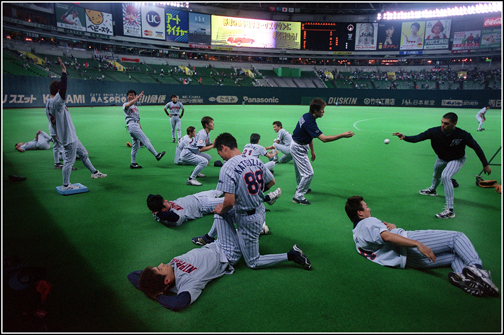
***
I arrived in Japan in the midst of World Cup fever. The Japanese national team had recently qualified for the round of 16, to be held in part in Japan, and everyone everywhere was wearing the team colors. World Cup stories dominated the news: Japanese citizens were getting modified Mohawk haircuts like England's David Beckham; there were post-victory soccer riots in Moscow; Brazil's Ronaldo was coming off a string of injuries - would he be ready to play?
Despite soccer being temporarily in the forefront of the people's minds, baseball - Japan's most popular sport, was still at the root. I found people playing "catch boru" in parks and parking lots. From the hills I could hear high school teams shouting during practices nearby. And images of Ichiro dominated the country like kudzu in a forest. Every Mariners game is broadcast on television in Japan. Dodgers' games are also broadcast when Kazuhisa Ishii is pitching. Television sports programs break down the video action of Japanese players in the Major Leagues like it was the Zabruder film.
"Ichiro is amazing, isn't he?" was the question every Japanese person asked me.
Of course, they already knew the answer; they were just so proud.
***
Japan is famous for importing things and making them their own. Zen Buddhism and automobile manufacturing, two things for which Japan is synonymous, were both originated abroad and re-tailored by the Japanese.
The same thing happened with baseball. They took our great American pastime and turned it into something just a little bit different: yakyu.
Yakyu, the Japanese word for baseball (which literally means "field ball"), resembles the sport in its superficial form. The pitcher's mound is 60 feet 6 inches from home plate and the diamond looks the same - although outfields tend to be a bit smaller, but the style of play is unlike it is in America.
In a land where television anchors bow at the beginning and end of their programs and the viewers benevolently respond with customary nods and grunts, form takes precedence over all. The same goes for baseball: there are certain things that you must do.
For example, if a pitcher beans a batter, the pitcher tips his hat to show that there was no intention involved. Should a runner take out a fielder during a slide, the runner is supposed to say, "Excuse me." And if a team goes on a losing streak, formal apologies are given to the fans.
The average score of a Japanese game more resembles that of a hockey game. Rarely are there lopsided contests. Home runs, while popular with the fans, remain but a bonus. If there is a runner on first base, you can be sure the next batter will bunt, regardless of the score. And 95 percent of the time, the fielder will take the bunted ball and make a play to first base, regardless of whether a play could be made elsewhere.
Each team is allowed four non-Japanese players, called "gaijin." The foreigners are often major leaguers at the end of their careers or career minor leaguers looking for a fat paycheck.
"The level of play is about Triple A," said Chris Seelbach, a starting pitcher for the Nippon Ham Fighters who spent eight years in the minor leagues with the Atlanta, Florida and Seattle organizations. "But each team has two or three players who could easily play in the major leagues."
Some foreign observers consider the Japanese version of the game too conservative, too boring. They don't consider that Japan is a society based upon both fierce competition and communal harmony. While winning is important, saving face is just as important. With that in mind, any game tied after 12 innings remains a tie. After 12 innings, both sides go home without shame.
"Spend your life over here and you have to be a little off," said Seelbach.
***
The Fukuoka Daiei Hawks had lost two games in a row and were down 1-0 in the bottom of the 8th inning on their home turf against the Nippon Ham Fighters. With one out and men on first and third, the Hawks seemed to have a chance. Hidenobu Matsunaka was swinging in the on-deck circle. He slid the donut off the bat and started to walk to the plate. Then Sadaharu Oh, the Hawks manager and one of Japan's living treasures, slowly walked out to the on-deck circle.
Sadaharu Oh is the world home run king. Over a 21 year career in the Japanese League, he hit 868 home runs, 113 more than major league leader Hank Aaron. And Oh, whose batting coach also trained him in aikido, Zen, Kabuki theater and the traditional art of swordsmanship, compiled his record in seasons that were 30 games shorter than Aaron's. If you do the math, Oh could have hit another 200 home runs in a comparable season.
Of course, he was facing weaker pitching at times, often in smaller stadiums. Still, Clete Boyer, the former Yankee who played in Japan for several seasons, said, "He's one of the best ballplayers I've ever seen. If Oh played in the U.S., he'd be a superstar. He'd probably lead the league in home runs and would hit with the best of them."
Oh reached Matsunaka, spoke softly to his batter and then patted him on his rear. It was a display of paternal affection from a man who rarely shows his emotions, the kind of moment you would never see at an American game. Matsunaka bowed reverently towards Oh and then stepped into the batter's box.
Matsunaka promptly grounded into an inning ending double play. Rather than throw his helmet or scream obscenities, however, he sprinted back to the dugout, gathered his gear and apologized to his skipper before taking the field.
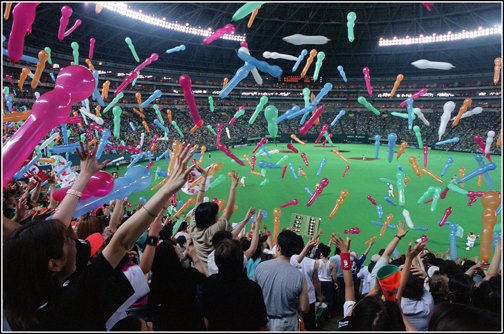
***
Yo Shibahara won that game for the Hawks with a two out, bases loaded single in the bottom of the ninth. The fans, none of whom left early to beat traffic, went wild. The sounds of horns and drums echoed throughout the stadium. The 40,000 people in the stands obediently sang the Hawks fight song as giant flags waved over their heads. The Hawks cheerleaders, dressed oddly similar to the Dallas Cowgirls, danced on the field with the mascots. And then all went silent as Yo Shibahara took the podium.
"I am just happy that we could win this game for the home crowd," he said, his words reverberating in the giant dome, the largest in Japan. He was standing on a box near the pitcher's mound, two stuffed animals in his hand, with cameras flashing and an mc holding a microphone to him. He was the star of the game.
He spoke some more about being proud of his teammates and then stepped off the podium and ran towards the dugout. The fans continued singing the team fight song. Shibahara threw the stuffed animals into the stands and with one last wave to the fans, disappeared into the bowels of the stadium.
Then everything went black.
A moment later, a spectrum of colors lit up the dome as the fireworks went off. The booming sounds blended with the banging of the drums and the crowd singing. It was deafening. The show lasted about five minutes and the lights came back on but the crowd still stayed. They cheered for another ten minutes before people finally began leaving the arena.
***
There are amusing contests within the Japanese game: Sherman Obando, a former Montreal Expo, hit a home run last year that pelted a Toyota billboard in the farthest reaches of the centerfield bleachers; the shot won him a car. This year Obando hit the Asahi beer sign in deep left and won 365 cans of beer.
It is the fans, however, that make the Japanese version of the game so unique.
About half of Japan's 120 million people root for Tokyo's Yomiuri Giants. The Giants are the oldest, most storied Japanese team and their games are broadcast nationally. The rest of the country roots for one of the other eleven teams. Teams have nicknames but are better known by the names of their corporate owners: the Yakult Swallows are owned by a yogurt maker, the Nippon Ham Fighters are owned by a meat production company, the Seibu Lions are owned by a department store chain.
At every game, at every stadium, there are "supporter" sections for both teams. The right field bleachers host the home team fans; the left field bleachers host the visitors. Each aisle in the bleachers has a lead cheerleader who directs the crowd on what and how to cheer. The result is a deafening, uniform battle cry, backed by horns and drums -- imagine Atlanta's tomahawk chop but with more spirit and better rhythm.
The supporters wave banners and clap using plastic team megaphones. They sing and dance and scream for players to hit home runs. Negative comments are never uttered in the supporter sections.
"It takes a while getting used to," said Rodney Pedrazza, a relief pitcher with the Fukuoka Daiei Hawks. "Whether you're getting killed or not, they are here until the end of the 9th inning. It's like their own little party out there."

